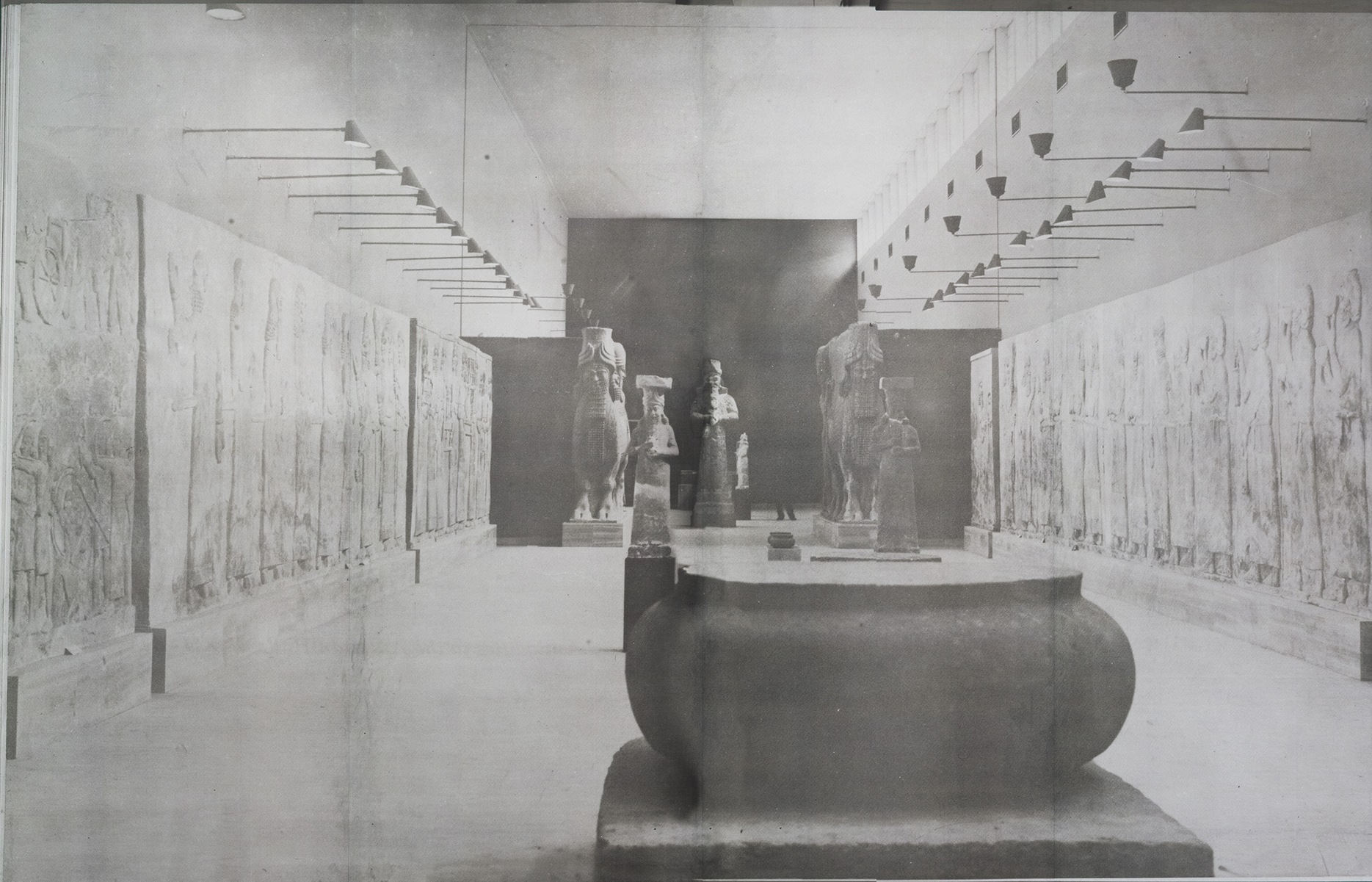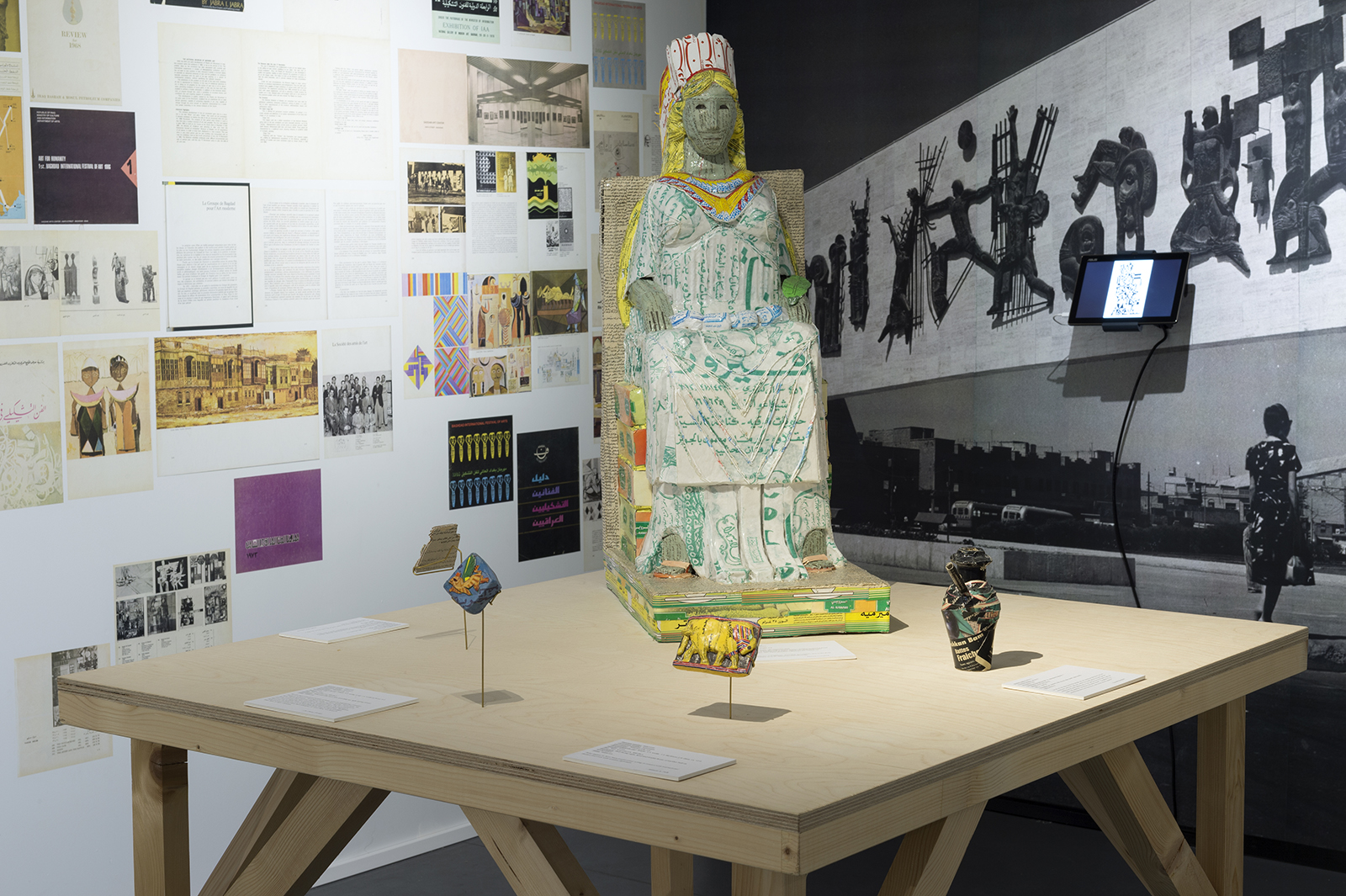There is no document of culture
that is not at the same time a document of barbarism.
Walter Benjamin
How is it possible to resign yourself to watching Baghdad and Iraq pass from being the cradle of mankind to the grave of history, from the Mesopotamian dream watering its land to the conflicts of the last few decades, relentlessly burning it? How do artists of all backgrounds (Iraqis, but not only) set forth on the trails of a heritage that is, if not erased, at the very least riddled with missing spaces? In this tragic context, how are we to re-think the fate of the national heritage, when the museum-city has seen its vestiges first moved to European museums, and then reduced to ashes?

THE GOLDEN AGE OF BAGHDAD
Iraq Museum, Assyrian art halls, lower floor, 1970s (Faraj Basmachi, Treasures of the Iraq Museum, Ministry of Information, Baghdad, 1975-1976)
Baghdad Mon Amour is intended as a collective investigation taking as its starting point the plundering of museums which became so widespread after the attacks and invasions first of the US army and then of the Islamic State terrorist group – creating a systematic dismantlement of the heritage. BMA is keen to explore the museum as the metaphor of a culture surviving somewhere between dream and nightmare, a culture which is showing itself to be all the more alive because it is resisting its programmed destruction – condemned not so much to extinction as to reinvention. Contrary to what might be thought, this surviving symptom does not date back to the Gulf War, but passes by way of the history of the avant-gardes in the 1950s and 1960s, and through the post-independence period of the 1930s – when the idea of the National Iraq Museum (also known as the “Baghdad Museum of Antiquities”) came into being and was implemented.

AFTER THE LOOTING
Joanne Farchakh-Bajjaly, photographic report on the looting of the Iraq Museum, April 2003. © Joanne Farchakh-Bajjaly
So everything started with the national museum, a pivotal resource in the making of modern Iraq from the 1930s onward, and the permanent symbol of an “antique modernity” to be reinterpreted by artists: the museum presentation of Islamic, Sumerian and Assyrian influences acts as a symbolic platform for the project of a new nation. It was also within this boundary that the forming of an artistic avant-garde would be played out. It featured such renowned artists as Jewad Salim, Lorna Salim, Shakir Hassan al Said and Dia Azzawi, who were keen to take part in this national movement of modernisation and, in a cross-disciplinary way, studied art, archaeology and architecture. They managed to create a hybrid aesthetic, inspired directly by national collections of antiquities, while at the same time ushering in an at once complex and straightforward dialogue with European modernism (reference to Picasso, for example, recurred regularly, but more in the form of a visual and ironic citation than an “influence” in the strict sense of the term).

PETITE RENAISSANCE IN PARIS
View of the exhibition “Baghdad My Love”, Institut des cultures d’Islam, Paris, 29.03-29.07 2018.
Photo © Marc Domage
We may well wonder if the history of the Iraqi national collections does not reveal a template of its kind, in both post-colonial and postmodern terms – the template of a form of modernisation understood as a process of formal hybridisation, or even formal self-conservation. In this respect, the national collection of modern art (presented in the 1960s in the Gulbenkian building in Baghdad before being transferred in the 1980s to the aptly named Saddam Art Centre) is all the more significant in that its works explicitly reinterpret the iconology and mythologies taken from collections of antiquities. This is a heritage intent on crossing borders (beyond the frontiers of the nation state and the post-colonial state), which is cosmopolitan and multifaceted, in the face of foreign and colonial domination (which certainly did not fade with the Independence of 1932) and faced more broadly today with the destruction of the heritage. Over and above past and present military invasions, many contemporary artists in Iraq and outside the country have devoted themselves to this protective impulse, be it in the form of allegory, parody, “archaeology in reverse” or reediting archives. The artists brought together in this volume and this exhibition, be they surveyors, archaeologists, archivists or poets, express a concern for a heightened sense of urgency since the American invasion of 2003; but also for a renewal of the critical and methodological tools for re-thinking how this heritage can be passed down. The looting of these collections has in fact given rise to as much illicit speculation as real scientific and heritage programmes involving Iraqi and non-Iraqi figures (in particular in British and American universities). So databases, whether compiled by customs and excise or academic, private or public bodies, are growing in number, paradoxically offering a new life to all these artefacts: theft and destruction are turned into systems of recollection and other areas of extreme circulation. The cross-border spirit of Mesopotamia and that of the Internet meet up, for better or for worse, creating an anachronistic space to be navigated in which artists are our compass.

PETITE RENAISSANCE IN PARIS
View of the exhibition “Baghdad My Love”, Institut des cultures d’Islam, Paris, 29.03-29.07 2018.
Photo © Marc Domage
In other words, it is a question of bringing together the archives of historical museums and the museums without walls of artists who, by appropriating tools such as the inventory and the study of monuments and documents, emerge with works that are anxious but ready to dance on ruins: works that carry within them both the phantom-like and traumatic museum of Iraq and its dream of a reinvented museum.
Morad Montazami
Symposium Baghdad Mon Amour / Institut national d’histoire de l’art, 30 May 2018